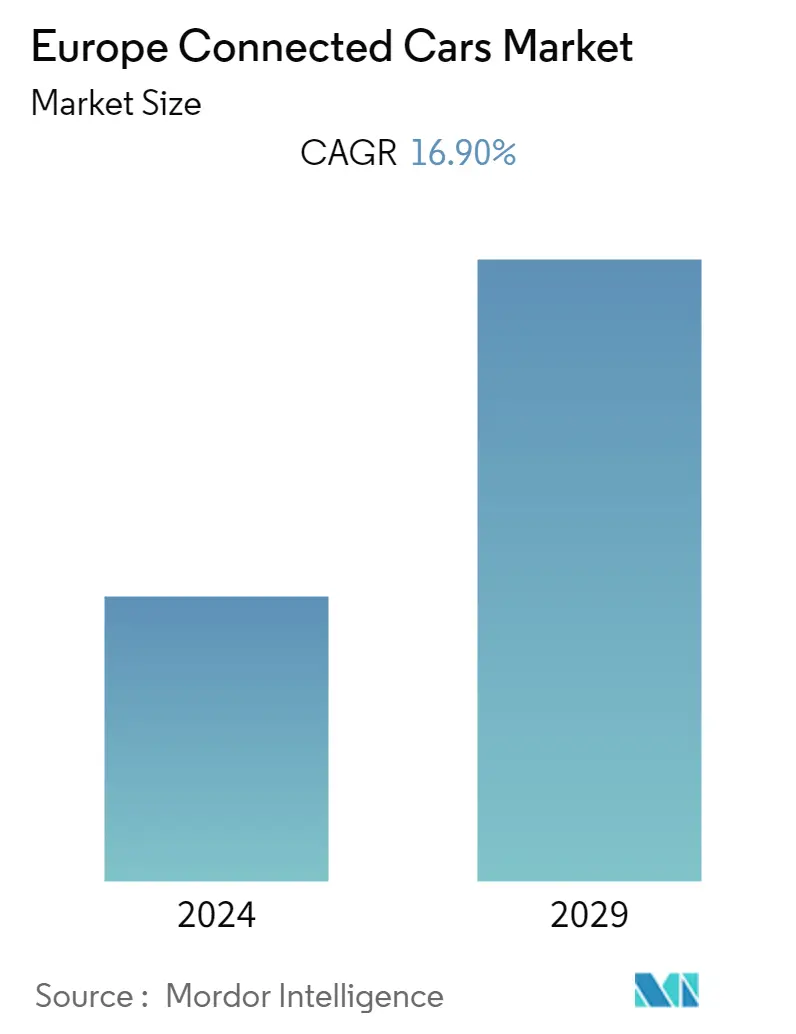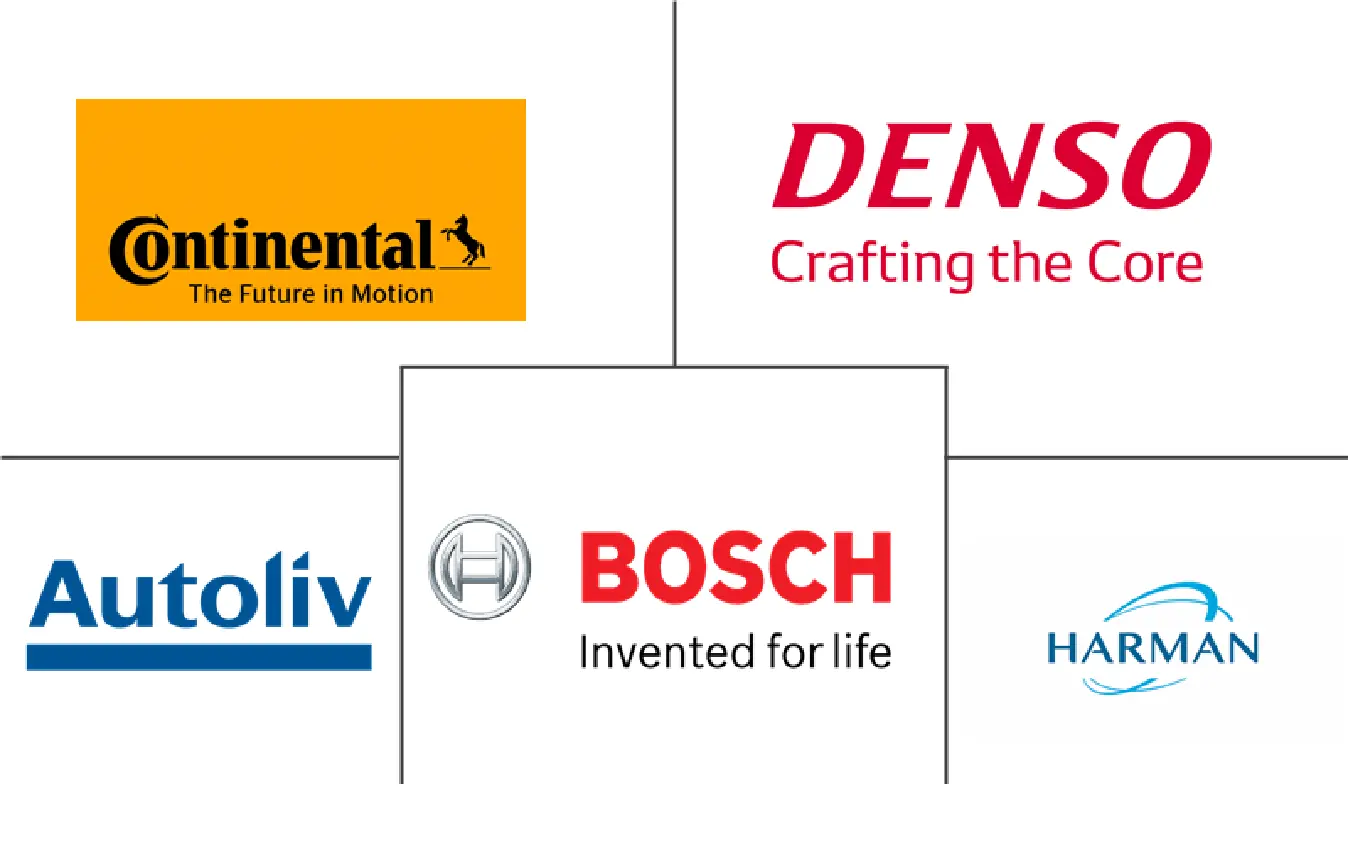Market Size of Europe Connected Cars Industry

| Study Period | 2019 - 2029 |
| Base Year For Estimation | 2023 |
| Forecast Data Period | 2024 - 2029 |
| Historical Data Period | 2019 - 2022 |
| CAGR | 16.90 % |
| Market Concentration | Medium |
Major Players
*Disclaimer: Major Players sorted in no particular order |
Europe Connected Car Market Analysis
The Europe Connected Cars Market was valued at USD 10.63 billion in 2021 and shall surpass the net valuation of USD 26.95 billion by 2027 while registering a solid CAGR growth of 16.2% during the forecast period (2022-2027).
The COVID-19 pandemic had a partial impact on the European-connected cars market. Although the stringent lockdown and social distancing norms indirectly affected the market by reducing the number of vehicle sales registered in 2020, the technical research into implementing the connected car system was continued remotely. The pandemic has also forced people to prefer private transport, which is expected to raise car sales worldwide, and, consequently, the connected cars market.
Over the medium-term, as European Union has framed several regulatory frameworks and ambitious goals to boost connected car networks, such favorable policies will positively impact the market. In April 2022, Data Act prosed by the EU offers a set of principles required for accessing data from connected products. This includes the right to access and share data and contractual business-to-business data exchange rights. This technological dominance and government frameworks drive the demand for connected cars in the EU.
There is a growing demand for connected car devices as they help monitor vehicles and drivers by exchanging critical information between nearby infrastructure and vehicles. Europe is home to many of the largest automotive technology manufacturers. Through innovative platforms, IoT and telematics together have enhanced connectivity, communications, and responses that offer infotainment, safety, security, and increased vehicle management to drivers, passengers, and commuters.
European Union accounts for almost 30% of the globally connected car fleet. Europe is also known for its extensive technological OEMs, which work in domains such as in-car entertainment, navigation, and in-car connectivity (for example, through Bluetooth), which have evolved rapidly over the last decade.
Europe Connected Car Industry Segmentation
A connected car is a vehicle connected to the internet, in other words, WLAN ( Wireless local area network). This helps the vehicles to share car data with external devices/services. The market studies thus cover all the technological aspects and latest developments in the market.
The European connected cars market is segmented by technology type, Connectivity type, Vehicle connectivity type, end-user type, and country. By technology type, the market is segmented into navigation, entertainment, safety, vehicle management, and other technology types. By connectivity type, the market is segmented into integrated, embedded, and tethered. By vehicle connectivity type, the market is segmented into V2Vehicle, V2Infrastructure, and V2X.
By end-user type, the market is segmented into OEM and aftermarket; by country, the market is segmented into Germany, France, the United Kingdom, and the Rest of Europe. For each segment, market sizing and forecast have been done on the basis of value (USD billion).
| By Technology Type | |
| Navigation | |
| Entertainment | |
| Safety | |
| Vehicle Management | |
| Other Technology Types |
| By Connectivity Type | |
| Integrated | |
| Embedded | |
| Tethered |
| By Vehicle Connectivity Type | |
| V2Vehicle | |
| V2Infrastructure | |
| V2X |
| By End-User Type | |
| OEM | |
| Aftermarket |
| By Country | |
| Germany | |
| France | |
| United Kingdom | |
| Rest of Europe |
Europe Connected Cars Market Size Summary
The European connected car market is poised for significant growth, driven by advancements in technology and supportive regulatory frameworks. The market is experiencing a surge in demand for connected car devices, which enhance vehicle and driver monitoring through the exchange of critical information with nearby infrastructure. The European Union's regulatory initiatives, such as the Data Act, are fostering an environment conducive to the expansion of connected car networks. The region's robust automotive technology sector, home to major OEMs, is at the forefront of integrating IoT and telematics to improve vehicle connectivity, safety, and management. The advent of 5G technology is particularly transformative, enabling unprecedented levels of vehicle-to-vehicle communication and collaboration, which are essential for the development of autonomous driving solutions.
Germany stands out as a key player in the European connected car market, with significant investments in research and development for autonomous vehicles. The market is moderately consolidated, with major players like Continental AG, Denso Corporation, and Robert Bosch GmbH actively pursuing partnerships and technological innovations to maintain a competitive edge. These companies are leveraging advancements in artificial intelligence, machine learning, and cloud technologies to enhance connected car systems. Strategic alliances, such as those between Harman and Amazon, and Volkswagen Group's electrification plans, underscore the industry's commitment to integrating advanced technologies and expanding the connected car ecosystem across Europe. As a result, the market is expected to witness substantial growth, supported by ongoing technological advancements and collaborative efforts among industry stakeholders.
Europe Connected Cars Market Size - Table of Contents
-
1. MARKET DYNAMICS
-
1.1 Market Drivers
-
1.2 Market Restraints
-
1.3 Industry Attractiveness - Porter's Five Forces Analysis
-
1.3.1 Bargaining Power of Buyers/Consumers
-
1.3.2 Bargaining Power of Suppliers
-
1.3.3 Threat of New Entrants
-
1.3.4 Threat of Substitute Products
-
1.3.5 Intensity of Competitive Rivalry
-
-
-
2. MARKET SEGMENTATION (Market Size in Value USD Billion)
-
2.1 By Technology Type
-
2.1.1 Navigation
-
2.1.2 Entertainment
-
2.1.3 Safety
-
2.1.4 Vehicle Management
-
2.1.5 Other Technology Types
-
-
2.2 By Connectivity Type
-
2.2.1 Integrated
-
2.2.2 Embedded
-
2.2.3 Tethered
-
-
2.3 By Vehicle Connectivity Type
-
2.3.1 V2Vehicle
-
2.3.2 V2Infrastructure
-
2.3.3 V2X
-
-
2.4 By End-User Type
-
2.4.1 OEM
-
2.4.2 Aftermarket
-
-
2.5 By Country
-
2.5.1 Germany
-
2.5.2 France
-
2.5.3 United Kingdom
-
2.5.4 Rest of Europe
-
-
Europe Connected Cars Market Size FAQs
What is the current Europe Connected Cars Market size?
The Europe Connected Cars Market is projected to register a CAGR of 16.90% during the forecast period (2024-2029)
Who are the key players in Europe Connected Cars Market?
Continental AG, Robert Bosch GmbH, Autoliv Inc., Harman and Denso Corp. are the major companies operating in the Europe Connected Cars Market.

